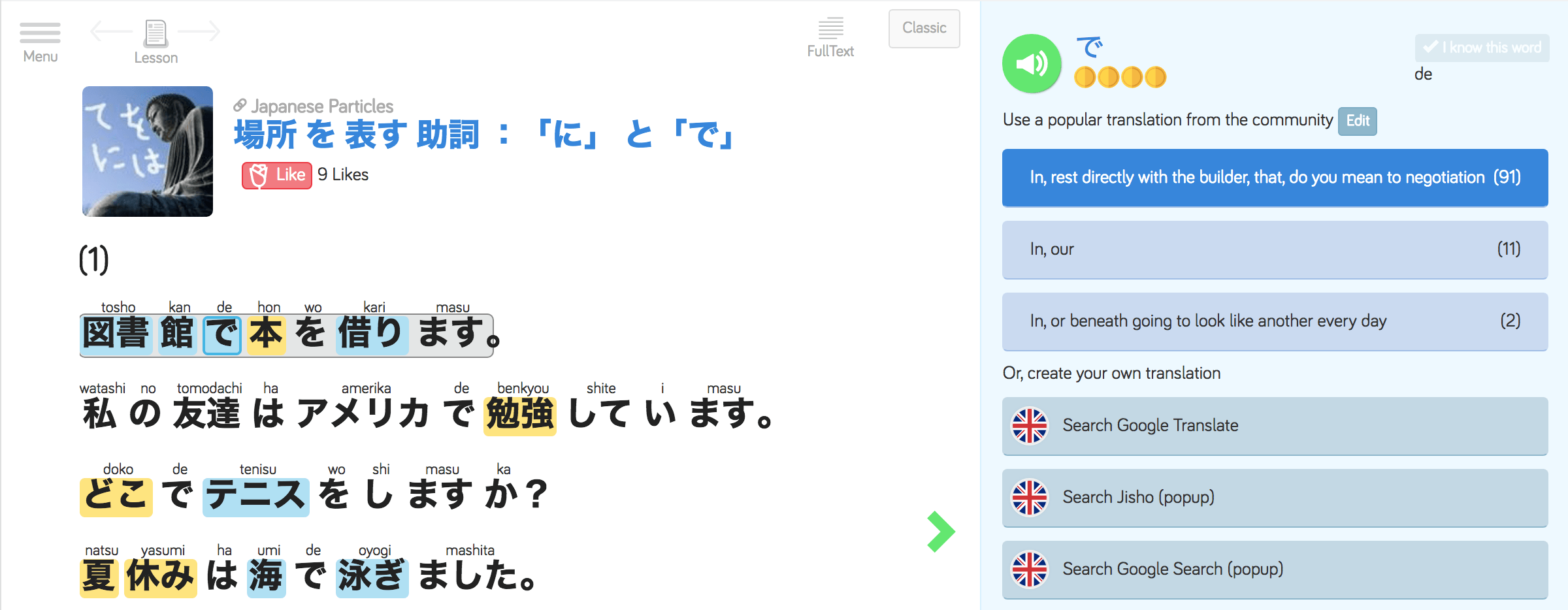Japanese Particles: an Introduction
Japanese is a language that is not dependent upon sentence structure so much as it is dependent upon particles (in Japanese, joshi, 助詞).
Particles are characters that relate a noun to another noun or verb. Particles are some of the most important things in Japanese grammar. As such, knowing what they are and how to use them is of the utmost importance, and, ultimately, the way to get used to them is by lots of practice and study. In this post, I will give a brief introduction to some of the most common Japanese particles.
The Topic Particle
The first particle to consider is は (pronounced “ha” normally, but when a particle, pronounced “wa”).
は is known as the topic particle, as it denotes the topic of concern. For instance, let’s use a very common sample sentence for those learning Japanese, “今日はいい天気ですね (kyou “wa” ii tenki desu ne).” This phrase means “The weather (天気) today (今日) is good (いい).” The topic particle indicates は indicates that the topic is “today (今日, kyou)”. The rest of the sentence says, “the weather is good (いい天気ですね, ii tenki desu ne)”. So, the topic particle indicates when the weather is good, which is today.

Here’s another exampled: “田中は (Tanaka “wa”)?”. 田中 is a name, pronounced “Tanaka”. This leaves a lot to context, but essentially it means, “What about Tanaka?” The topic particle indicates that there is something about Tanaka that the speaker is concerned with. A suitable answer can be something like, “田中は明日 ( Tanaka “wa” ashita)”, which means that Tanaka is tomorrow. This doesn’t make sense in English, but it does make sense in Japanese with the appropriate context. This presumably would be a conversation about something that Tanaka is doing tomorrow, or something that is being done to Tanaka tomorrow. The topic is shown clearly to be Tanaka here.
There is another particle that essentially means the same thing, but with the additional meaning of “as well”. This particle is も (mo). To relate back to the first example, if you were to say “今日もいい天気ですね (kyou mo ii tenki desu ne)”, it would mean “The weather is good today as well.” As in the English translation, this implies that the weather was also good on other days as well as today.
The Subject Particle

The next particle is another common one, が (ga). It can be used for a variety of things. For instance, it can indicate that the previous information is background information.
Usually, this can be translated like the English “but” and likewise, but sometimes it is better translated as “and”. An example of が in this common way would be “先生ですが, 私も勉強しますよ (sensei desu ga, watashi mo benkyou shimasu yo)”, meaning “I am a teacher, but I also study”. However, it also is commonly used to indicate the subject. For instance, “僕が学生 (boku ga gakusei)”, “I am a student.” This may seem very similar to the は particle, and I am sure a whole small book could be written on the difference between は and が, but essentially, が is used to describe something while は indicates the topic.
It can take a lot of practice to get used to as in English it is not so easy to identify the different nuance in what is meant in the subject. For an illustration of the difference, consider the following sentence: “私は太田さん。私がサラリーマン (watashi “wa” Oota-san. Watashi ga sarari–man), I (私) am Oota-san (太田さん). I am a salaryman (サラリーマン)”. The は particle shows the topic, “私 (watashi)” and the が particle adds information about the subject.
Japanese Particles with Verbs
So far, we have looked at some very common Japanese particles concerning statements. Next, let us take a look at particles when used in sentences involving verbs (though the translations included linking verbs, no verbs were used in the Japanese).
It is easier to think of the は particle and が particle as having very similar uses in both declarations and sentences with verbs. は indicates who or what is the topic of the sentence. For instance, “僕は行く(boku “wa” iku)”., which translates to “I (僕) am going (行く).” Similarly, が can be used to indicate who or what is doing the action. You can say, “僕が行く (boku ga iku)”, which is translated in much the same way, but holds a nuanced difference in meaning, similar to when used in declarations.
A lot of practice can help with realizing what to use at what time. There are also examples when は indicates the topic of the sentence and が indicates the subject, such as when you say, “西尾は猫が欲しい (Nishio “wa” neko ga hoshii)”, which would mean Nishio (西尾) wants (欲しい) a cat (猫). The は particle indicates who is the one that wants, while the が particle indicates what it is that is wanted.

The を ((w)o) particle is similar to が in that it is also used to indicate the direct object of a sentence, and this is about it’s only purpose in modern Japanese. “肉を食べたい! (niku (w)o tabetai!)” in English means that an undisclosed someone or something wants to eat (食べたい) meat (肉).
The Directional Particles
The へ character is normally pronounced he, though when it is a particle, it is pronounced e. It indicates that the place or state indicated by it is where the subject is headed towards. Note that this does not mean necessarily that the place or state headed towards is reached or that it is the final intended spot. If you say, “イタリアへ行った (Itaria “e” itta)”, it does not mean strictly that the person went to Italy, but that he/she/it went towards Italy. It would be translated as “(Undisclosed subject) set out (行った) toward Italy (イタリア)” and such.

A similar yet different particle means that the subject went to Italy. “イタリアに行った (Itaria ni itta)” would mean that “(Undisclosed subject) went to (行った) Italy (イタリア)”. The difference is that this particle is the に particle. This particle can also be used with verbs that don’t indicate a location, such as becoming something. For instance, “作家になりたい (sakka ni naritai)”, which means that the undisclosed subject “wants to become ( なりたい) an author (作家).
It should be noted that this character is also used in lists of subjects, similar to the word “and”, such as in the phrase “シャツにパーカー (shatsu ni pa–ka–), which means a shirt and parka, which is a type of fashion statement that can look very good if done well.
Overall, this as been a very brief overview of some of the more popular Japanese particles. This in no way is an exhaustive overview of them or particles in general. To learn to get used to these particles and many more, continue studying and practicing. Luckily for you, LingQ has got you covered to easily and readily study and practice Japanese. As well as studying particles through repeated exposure to the interesting lessons in the Japanese library, you can find lessons that specifically cover the Japanese particles, like this one:

Best of luck on your Japanese learning journey!
***
Caiman Cotton is a freelance Japanese translator who has studied the language for years. He hopes to one day also study Latin.


